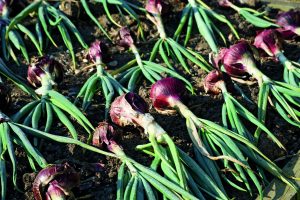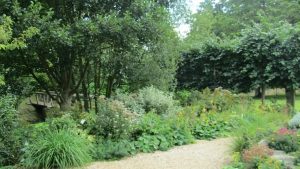Secret Gardens of East Anglia – Polstead Mill
Lucy Bartlett began her gardening life in mellow and moist South Wales. When newly settled in Suffolk, she thought she had moved to a desert.
Now it feels like her terroir, but in the beginning it was a real journey of discovery. “I learned that going East means you actually have to water plants,” she says. Lucy and her husband Richard found Polstead Mill in 2002. The house dates from 1785 and was incorporated with the adjacent mill in 1947. Up until then, this was a working mill, complete with a mill race, weir and pool leading off the River Box, which runs through the garden. Features such as the swimming pool, built over the former mill race, and the terrace, path and steps in front of the house, were put in by their immediate predecessors. By the time the Bartletts arrived, however, there was plenty of scope for renewal and expansion. The garden at Polstead Mill covers around 4.5 hectares/11 acres and now includes a tree-fringed lawn and herbaceous borders near the house, and a kitchen garden, woodland and wildflower meadow reached by crossing either of the two bridges over the river.
Plant Palette
The garden is very much Lucy’s domain. She describes herself as a selfish gardener: ‘My parents were passionate gardeners, martyrs to their garden you could say. But I need the garden to do what I want, rather than it dictating how we live.’ While Richard supports Lucy wholeheartedly in this, he does not intervene in the garden except to pleach the limes.
Early on, Lucy attended classes run by Frances Mount, a legendary Polstead plantswoman who when young had gardened with Cedric Morris at Benton End, near Hadleigh. It was thanks to these tutorials that Lucy came to understand the plant palette that would work well here. But first things first – and this meant doing battle with some unwanted elements.
The initial assault was on 35 overgrown Leland cypresses (x Cuprocyparis leylandii) that, by dint of their girth, had effectively shrunk the informal lawn to a fraction of its size. The felled Leylands still have a place in ther garden, as Lucy recycled them almost immediately to replace the old footbridge that had floated away during a storm in the winter of 2002. Freeing up the informal lawn has made space for more shrubs and trees, which make a gentle curve along the line of the river, across the far edge of the lawn and back towards the pond. In the late spring and early summer the grass close to the road and riverbank is left unmown to froth with the white of cow parsley.
The Bartletts put in a better approach to the house, replaced all laurel hedges with beech, and gave the garden a consistent look by installing wooden gates and metalwork made to Lucy’s specifications by Lavenham Joinery and Gedding Mill forge. It was at this time that Lavenham garden designer Janey Auchincloss proved invaluable, for her ability to turn Lucy’s ‘scribbles’ into workable designs.
During this rebuild time the Bartletts restored many of the walls, as well as the main bridge over the River Box. On finding the newly renovated bridge suddenly too stark, Lucy felt wisteria would be the answer and bought several. It took six years for the plants to flower, and the Bartletts trim them back quite fiercely at regular intervals, but they always make a wonderful show in the early summer.
Foliage With Texture
Once the heavy work was done, Lucy could re-garden in earnest and concentrate on the herbaceous borders. She felt it was important to give the garden a ‘backbone’ by using structural plants, as well as a variety of foliage and texture. ‘I am relaxed about plants that become a bit wayward, providing there is an underlying structure,’ she says. The view from the kitchen takes in her flamboyant new plantings alongside the pond, a relic of the mill race. Lucy admits that the mix of purples, reds and yellows ‘is pure whimsy’, formed exclusively of plants she likes.
Although there is an emphasis throughout the garden on foliage and a green tapestry effect, Lucy confesses to loving once unfashionable but nonetheless bright and boisterous lupins, dahlias and hollyhocks before they began ‘trending’. She grows these in deep borders devoted to cut flowers in the Kitchen Garden.
This playfulness belies the fact that Lucy is secretly a ‘provisional catastrophist’ in the garden – she tries to future-proof important elements of it, an approach perhaps derived from her former career as a stockbroker. Waiting in the wings is a young specimen of a rare Polstead black cherry, ready to replace the mature tree that looked about to keel over in 2002 (but which, against the odds, is still going strong). Nor does Lucy want the garden to be a burden as time progresses. She prefers to anticipate change, even if it means contemplating a reduction in size. ‘At least if there is a good structure you can shrink down a border or two if necessary,’ she says.
It would be a tough call, though, as each party of the garden has its own character. The Yorkshire terrace in front of the house, softened by two lozenges of closely mown lawn, is a set piece combination of formality and gently flowing plant structure. Flights of steps with randomly self-seeding Alchemilla mollis sashay out from the terrace into the generally gravelled entrance court adjacent to the river. Against the house are ample borders where lines of box, shaped into cones, are softened by repeated Alchemilla mollis, other perennials, and roses including ‘Bonica’ and ‘Buff Beauty’. The house walls here are clad with rambling Rosa ‘Alberic Barbier’, whose apricot to lemon blooms perfume the air in summer.
Low brick walls surrounding the swimming pool and its garden make a sheltering backdrop on the outer side for new borders to frame the Terrace Garden. These are packed with mounding plants with softly purple or grey foliage and pastel flowers. The colour scheme continues around the pool, where the shape of stately cardoons is echoed in a silvery sculpture by Tom Hitchcock of Gedding Mill.

The Cook’s Garden
 In 2009 the Bartletts began more extensive work to create the Kitchen Garden and stylish glasshouse. This plot of 0.4 hectares/1 acre is the heart of family life throughout the summer, and also an enjoyable social space for entertaining friends. For Lucy, it is the best ‘out-sourceable’ part of the garden and is where she is at her most hands-on: ‘I am the cook and therefore the kitchen gardener.’ She sows and plants according to what is needed as and when – large harvests in August and September, less in the quieter month of July. The red brick walls of the Kitchen Garden provide support for pears, apples and figs, while wood-edged raised beds arranged in clusters create an attractive area for food production. At the centre of each group of beds are customised metal containers inspired by the old-fashioned oval cake tins used by Lucy’s grandmother. These are perfect for herbs and strawberries. The Kitchen Garden’s bounty is either served up fresh or processed and preserved in various ways in the wellequipped kitchen behind the glasshouse.
In 2009 the Bartletts began more extensive work to create the Kitchen Garden and stylish glasshouse. This plot of 0.4 hectares/1 acre is the heart of family life throughout the summer, and also an enjoyable social space for entertaining friends. For Lucy, it is the best ‘out-sourceable’ part of the garden and is where she is at her most hands-on: ‘I am the cook and therefore the kitchen gardener.’ She sows and plants according to what is needed as and when – large harvests in August and September, less in the quieter month of July. The red brick walls of the Kitchen Garden provide support for pears, apples and figs, while wood-edged raised beds arranged in clusters create an attractive area for food production. At the centre of each group of beds are customised metal containers inspired by the old-fashioned oval cake tins used by Lucy’s grandmother. These are perfect for herbs and strawberries. The Kitchen Garden’s bounty is either served up fresh or processed and preserved in various ways in the wellequipped kitchen behind the glasshouse.
 Beyond the Kitchen Garden is a gently sloping wildflower meadow sown on the depleted soil of a former commercial strawberry field. The informal grove of pear trees, crab apples, nuts and apples is valued both for produce and blossom. Spring bulbs including Lilly of the valley, snowdrops and bluebells bloom in profusion here and in the woodland adjacent – although, as Polstead Mill lies in a frost pocket, they tend to emerge later than in other gardens. The meadow is where the children enjoy camping and is also the site of one of Lucy’s favourite garden seats, with a view across the wisteria-covered bridge to the house beyond. ‘It is so important to have places within the garden where I can sit without thinking I have to pull out weeds,’ she says. The temptation, though is never to sit down.
Beyond the Kitchen Garden is a gently sloping wildflower meadow sown on the depleted soil of a former commercial strawberry field. The informal grove of pear trees, crab apples, nuts and apples is valued both for produce and blossom. Spring bulbs including Lilly of the valley, snowdrops and bluebells bloom in profusion here and in the woodland adjacent – although, as Polstead Mill lies in a frost pocket, they tend to emerge later than in other gardens. The meadow is where the children enjoy camping and is also the site of one of Lucy’s favourite garden seats, with a view across the wisteria-covered bridge to the house beyond. ‘It is so important to have places within the garden where I can sit without thinking I have to pull out weeds,’ she says. The temptation, though is never to sit down.
Lucy’s garden is open by appointment for the National Garden Scheme www.ngs.org.uk
This article is taken from Secret Gardens of East Anglia by Barbara Segall, £20 Frances Lincoln. Photography by Marcus Harpur.
Ingredients for Cooks – Lucy Bartlett
“My husband loves sun-dried tomatoes in industrial quantities and being a dedicated kitchen gardener and cook I wanted the best we could find. I sourced them from a particular outlet and that was that: we enjoyed them and purchased them in quantity. A few years later for various reasons we owned the company. We took it over as it fell on hard times and it was in danger of closing. So mine was an accidental route into this business.” But there is nothing accidental about how her involvement with Ingredients for Cooks has developed. Lucy is a perfectionist and wants products that home cooks are going to use to be delicious and affordable in the more-than-daily-shopping quantities that they need. No wonder the byline of the company is “Purveyors of Deliciousness, Sharing Delicious Food made that little bit Easier”. “I am looking for the products that families want to use and need to purchase at a good price because they use or eat it in an out-of-proportion quantity. If they purchased from the supermarket they would be out of pocket and as they are not in catering they can’t purchase wholesale… so Ingredients for Cooks is the half-way point between those two”. “Every family has something that they devour in this way: it could be Manchego cheese, Parmesan, frozen clotted cream portions or Tiptree jams – some of our most popular lines”. Lucy describes herself as a passionate foodie and gardener and Ingredients for Cooks ties in with her own cooking and baking interests… she bakes huge quantities of cake, biscuits, scones, brownies etc for her ‘By Appointment’ garden visitors (see article). And it was also the need for more than a supermarket-shop’s worth of flour, icing sugar, cooking chocolate etc, that led her to appreciate a better price point, but for quality products. “I want to offer items that I can vouch for, that are restaurant-quality for cooks that are as discerning as chefs, yet the pricing is just as affordable for events of scale such as weddings or simply for home dining”. There is great demand from home wedding caterers for cheeses to make towering cheese wedding cakes, and if you love cheese anyway, Ingredients for Cooks has access to some 18,000 cheeses. Lucy says that if there is something that you are particularly looking for get in touch as they have access to so many products beyond those that are regularly in stock. “One of our most popular lines is frozen avocados. These are sold halved so you can see the quality of them. And you can use what you need… no waste!”
Visit Ingredients for Cooks website www.ingredientsforcooks.co.uk
Interview by Barbara Segall



